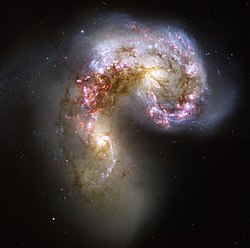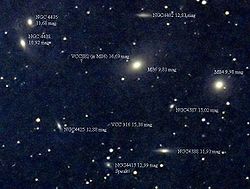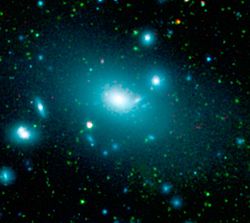Know in Depth
In this section you will be able to learn a little more in depth about the objects that we will see in the astronomical observation of the month. Choose the astronomical object you want:
Galaxia Irregular de Corvus

The Antennae or Antenna Galaxies are two interacting galaxies in the constellation of Corvus. They were discovered in 1785 by William Herschel.
The Antennae galaxies (NGC 4038 and NGC 4039; Arp 244 in Halton C. Arp’s Atlas of Peculiar Galaxies) are part of the NGC 4038 Group along with five other galaxies. They are experiencing a galactic collision and are called the Antennae or Antenna for the long lines of stars, gas and dust that are the result of the collision, and are reminiscent of the antennae of an insect.
The nuclei of both galaxies are coming together to form a super galaxy, probably an elliptical or spiral galaxy, while the tails will eventually break apart and become independent, forming smaller satellite galaxies.
Gran Cúmulo de Virgo

The Virgo Supercluster, or Local Supercluster, (in English ‘Local Supercluster’ or LS) is the supercluster of galaxies that contains the Local Group and with it, our galaxy, the Milky Way.
The supercluster contains about 100 groups and clusters of galaxies, and is dominated by the Virgo cluster, located near its center. The Local Group is located near the edge of the Virgo cluster, to which it is drawn.
Elíptica Gigante de Coma Berenice

NGC 4889 is a giant elliptical galaxy located at an estimated distance of around 320 million light years and can be seen with amateur telescopes. It is the brightest member of the Coma Cluster, intrinsically much brighter than the two brightest galaxies in the Virgo Cluster (M49 and M87).
NGC 4889 is an excellent example of the type of elliptical galaxies that often occupy the central regions of rich galaxy clusters, with a bright center and a huge diffuse envelope around a diameter estimated to be between 250,000 light-years2 and 330,000 light-years. , 3 in which in addition to a rich system of globular clusters, with a population of them that has been estimated at around 12,000,4 there are even smaller embedded galaxies.5
The nebula measures approximately 37.0 ‘x 19.0’ and is approximately 1,500 light years distant from Earth. [2] The proper motion of the central star is believed to date back to the Orion Belt area. [2] The nebula is about 5 light years across.

